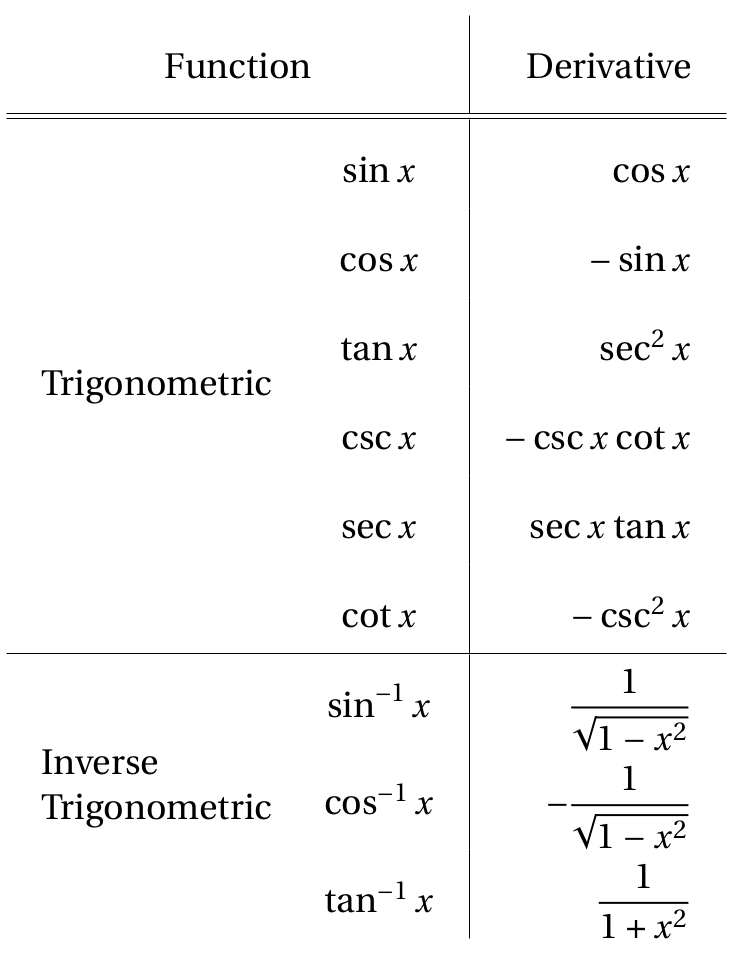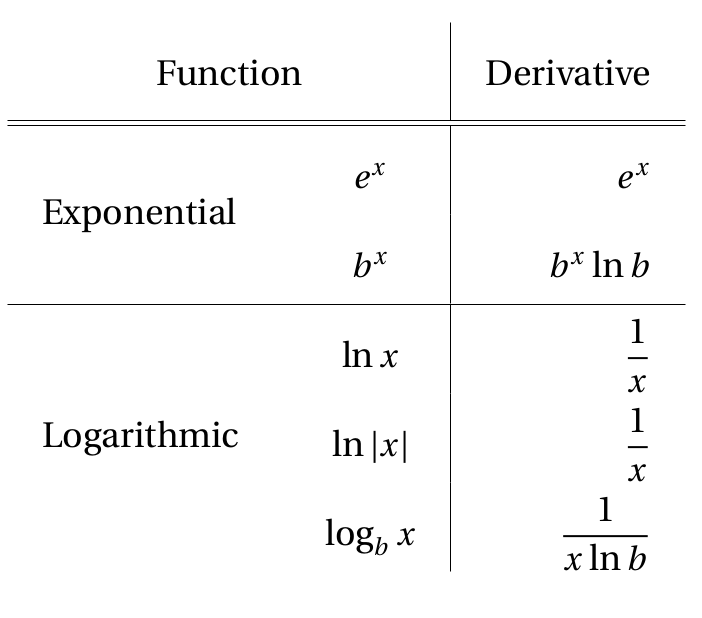(D6) Proving Elementary Derivatives#
By the end of the lesson you will be able to:
prove the formulas for the trigonometric derivatives.
prove the formulas for the inverse trigonomentric derivatives.
prove the formulas for the logarithmic derivatives.
Review Videos#
These are the videos for the topics we covered during class time (in case you want to go back and review what we covered).
Elementary Form Derivatives#
Now that we have looked at all of our different derivative rules and techniques, we can actually prove many of the elementary form derivatives listed on the tables below.
Technically, all we need to know are the 3 derivatives for sine, cosine, and the natural exponential function.
Everything else can be proved from these using either: product rule, quotient rule, chain rule, or implicit differentiation. Although it is still a very good idea to have all of these elementary form derivatives memorized.
(As usual, we use the convention that the angle for the trigonometric functions are given in radians.)


Example 1#
Use derivative rules to prove the following derivative formulas:
\(\dfrac{d}{dx}\big[\tan x\big] = \sec^2 x\)
\(\dfrac{d}{dx}\big[\sec x\big] = \sec x \tan x\)
Click through the tabs to see the steps of our solution.
The first thing we need to do is rewrite each of these in terms of the sine and cosine functions.
We start by rewriting the \(\tan(\cdot)\) function in terms of sine and cosine:
This is a quotient, with an \(x\) term in both the top and bottom of the fraction. So we can use quotient rule.
From here we can simplify using some of our trigonometric identities: \(\sin^2 \theta +\cos^2\theta = 1\) and \(\sec\theta = \tfrac{1}{\cos \theta}\).
Which is the result we wanted to show!
The work will be similar to what we showed for the tangent function \(\tan (\cdot )\).
Try this one for yourself using one or more of the following trigonometric identities:
Inverse Functions#
Definition of an Inverse Function
The function \(f^{-1}\) is the inverse function of \(f\) provided:
for any \(x\) in the range of \(f\).
Note: The \(-1\) that we see here is purely part of the notation. It is not actually an exponent. There is a significant difference between the inverse of a function, and the reciprocal.
Cancellation Properties
For all \(x\) in the domain of \(f\) we have \(f^{-1}\big( f(x) \big) = x\)
For all \(x\) in the domain of \(f^{-1}\) we have \(f\big( f^{-1}(x) \big) = x\)
Example 2#
Use implicit differentiation to show:
Click through the tabs to see the steps of our solution.
The first step is to use the definition of the inverse function.
The first step is to apply the definition of the inverse function so that in some way we can rewrite our expression using the original \(\sin (\cdot )\) function instead of its inverse.
To simplify the notation, let’s rename the output of our function \(y\). That is, let:
Apply the \(\sin (\cdot )\) function to both sides of this equation to get:
Using the cancellation property of inverse functions, the right side simplifies to just \(x\):
Now we can use implicit differentiation to calculate \(y'\).
Next we need to convert all instances of \(y\) back to \(x\). For trigonometric functions, one way to do this is with a right triangle.
If we go back to our equation from earlier, \(\sin y = x\), we can use this to set up the sides of our right triangle:
Comparing the fractions, we see that the length of the opposite side (\(\text{opp}\)) of the right triangle must be \(x\), and the length of the hypotenuse (\(\text{hyp}\)) must be \(1\).
Using the Pythagorean Theorem, we can then calculate the length of the adjacent side (\(\text{adj}\)) to be \(\sqrt{1-x^2}\).
Therefore, we can convert \(\cos y\) into \(x\)-terms using:
Finally, we are ready to solve for our derivative \(y'\):
Which is the result we wanted to show!
Example 3#
Use implicit differentiation to show:
Click through the tabs to see the steps of our solution.
The first step is to use the definition of the inverse function.
The first step is to apply the definition of the inverse function so that in some way we can rewrite our expression using the original \(\tan (\cdot )\) function instead of its inverse.
To simplify the notation, let’s rename the output of our function \(y\). That is, let:
Apply the \(\tan (\cdot )\) function to both sides of this equation to get:
Using the cancellation property of inverse functions, the right side simplifies to just \(x\):
Now we can use implicit differentiation to calculate \(y'\).
Next we need to convert all instances of \(y\) back to \(x\). For trigonometric functions, one way to do this is with a right triangle.
If we go back to our equation from earlier, \(\tan y = x\), we can use this to set up the sides of our right triangle:
Comparing the fractions, we see that the length of the opposite side (\(\text{opp}\)) of the right triangle must be \(x\), and the length of the adjacent side (\(\text{adj}\)) must be \(1\).
Using the Pythagorean Theorem, we can then calculate the length of the hypotenuse (\(\text{hyp}\)) to be \(\sqrt{1+x^2}\).
Therefore, we can convert \(\sec y\) into \(x\)-terms using:
Finally, we are ready to solve for our derivative \(y'\):
Which is the result we wanted to show!
Example 4#
Use Chain Rule to show:
Click through the tabs to see the steps of our solution.
Hint: First rewrite the exponential function in terms of the natural exponential function, using:
The first (and major step) in proving this derivative rule is to rewrite the general exponentila in terms of the natural exponential function, using:
Why is this true though? A few reasons:
There is a log property that let’s us bring constant multiples inside the log function where they become an exponent: \(x\ln b= \ln b^x\)
Inverse functions \(e^{(\cdot)}\) and \(\ln(\cdot)\) have cancellation properties when they are directly next to each other in a composition.
Putting this together, we have:
With this different version of our funciton in mind, we’re able to calculate the derivative using the Chain Rule.
Which is the result we wanted to show! (Note that in the last step, we used that property again to convert the exponential term back to just \(b^x\).)
Example 5#
Use implicit differentiation to show:
Click through the tabs to see the steps of our solution.
The first step is to use the definition of the inverse function.
The first step is to apply the definition of the inverse function so that in some way we can rewrite our expression using the original \(b^{ (\cdot )}\) function instead of its inverse. (Remember that logarithmic functions are just inverse exponential functions.)
To simplify the notation, let’s rename the output of our function, \(y\). That is, let:
Apply the \(b^{ (\cdot )}\) function to both sides of this equation to get:
Using the cancellation property of inverse functions, the right side simplifies to just \(x\):
Now we can use implicit differentiation to calculate \(y'\).
Next we need to convert all instances of \(y\) back to \(x\). The only \(y\) term in our equation is the \(b^y\) term, and we know what this is after we used the cancellation property:
Using this gives us:
And then solving for \(y'\) we get:
Which is the result we wanted to show!
Example 6#
Use Chain Rule to show:
Click through the tabs to see the steps of our solution.
The first step is rewrite the absolute value function as a piecewise function.
We start by rewriting the absolute value function as a piecewsie function:
Take a moment to convince yourself that this is correct. Essentially, the absolute value function:
if the input is positive, does nothing. \(|x|=x\) if \(x\) is positive.
if the input is negative, then the absolute value function introduces a double negative. \(|x|=-x\) if \(x\) is negative. Negating a negative number, gives you a positive.
If \(x\) is positive, we can calculate the derivative of \(\ln |x|\) using the the first piece of our piecewise function:
This proves the result when \(x\) is positive.
If \(x\) is negative, we can calculate the derivative of \(\ln |x|\) using the the second piece of our piecewise function:
This proves the result when \(x\) is negative. And therefore, we have proved the result for all possible cases of \(x\). Note that \(\ln 0\) is undefined, so we do not need to actually consider the case when \(x=0\).
